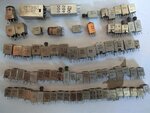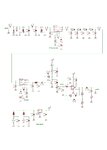Garyl
Full Member level 5
I really want to learn some of the analogue stuff and I know that I need to have IF cans for that.
They are used in many radio receivers and transmitters circuits.
I have looked into my stockpile and found that:

Then I tried to find datasheets for them, and....
... I realized that searching for their codes in Google gives literally nothing!
There are no information, no datasheets, not a single mention of those cans...
Am I doing something wrong, or what's the matter? Is there really no information, no datasheets of IF "can" transformers?
Can anyone help me?
PS: I am attaching a high-res photo of my IF transformers collection, maybe someone can at least recognize few of them? 455kHz, maybe?
They are used in many radio receivers and transmitters circuits.
I have looked into my stockpile and found that:

Then I tried to find datasheets for them, and....
... I realized that searching for their codes in Google gives literally nothing!
There are no information, no datasheets, not a single mention of those cans...
Am I doing something wrong, or what's the matter? Is there really no information, no datasheets of IF "can" transformers?
Can anyone help me?
PS: I am attaching a high-res photo of my IF transformers collection, maybe someone can at least recognize few of them? 455kHz, maybe?


